CHAPTER 7: VILLAGE BUSINESSES AND FAMILIES
- The Village Stores and Shopkeepers: Mary Rose, Gerrard, Billen, Drake.
- The New Inn, Innkeepers and Brewers
- Carpenters: Messrs Squire, Lockett, Smith, Saint, Gale
- Blacksmiths: The Way Family
- Milling and Millers at the Manor Corn Mill
- Thatching: Messrs Hansford & Osgood
- A Boot-repairer: Ambrose Brown
- Joey Hardy & Snowdrop Sunday
The community of Piddlehinton was almost completely self-sufficient until the 19th century. Most of the occupations of village folk were directly or indirectly concerned with farming. Other employment reflected the changing pattern of village life. The earliest information which gives some insight into the standard of living of the Piddlehinton community is obtained from probate inventories of the more wealthy residents between the years 1664 and 1778. Fourteen such lists of personal property exist. Of these, seven were farmers (only four were more than smallholders), two were brewers and one was a pedlar.
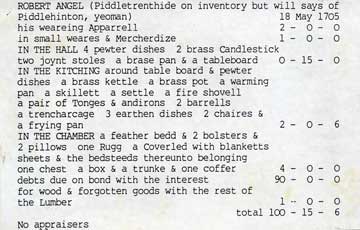
To the right is the Inventory of Robert Angel on 18 May 1705, a Chapman (pedlar) who calls himself a yeoman. The pedlar and one of the brewers were amongst the three wealthiest. The average value of house contents, £26. 16s. 3d. is an extremely low figure for that time. The community was impoverished with a great divide between the top five and the remaining nine listed.
Kelly's Directory and census entries give a good representation of the diverse trades to be found in Piddlehinton in the latter half of the 19th century. On the farms there were farmers/yeomen, a bailiff, carters, ploughmen, shepherds, dairymen and maids, agricultural engine drivers and many general agricultural labourers. Craftsmen and manufacturers included boot and shoemakers, a cordwainer, button-makers, a saddler and harness-maker, a tailor and tailoresses, seamstresses and dressmakers, a straw milliner, mop makers, glovemakers, a twine spinner, a basket maker, thatchers/woodmen/hurdlers/spar-makers, masons and bricklayers, plasterers, carpenters and blacksmiths. Many residents provided services - bakers, millers, innkeepers and brewers, shopkeepers, butchers, a chimney sweep, laundresses, nurses, a nursemaid and a midwife, school mistresses and governesses, policemen, rectors, coachmen and a footman, ladies-, parlour-, house- and kitchen-maids, housekeepers, gardeners and cooks. A Major General along with Chelsea pensioners and a pensioner from the R&D Guards, fund holders, an office clerk, land agents, a registrar of births and deaths, a tax-collector, a printer compositor, anuitants and proprietors are also listed. In 1851, 89 households had a total population of 391. Of these, 288 people were aged 10 or over, and of these 128 residents were involved in farming occupations, 38 in crafts or manufacturing and 58 in services. Some of the occupations are featured in more detail in the following accounts of families or their trade. Farming families are mentioned in Chapter 4.
In the 1841 census, William Purchase, Edmund Caundle, Ann Caddy and Joseph Cross are all listed as shopkeepers. From 1845-1851, Thomas Trimm is noted as a grocer. In 1851, Ann Caddy is listed as grocer, Joseph Cross, Elizabeth and John Prior as grocery dealers, and Alfred Squire as shopman. By 1855, Miss Elizabeth Beck, Joseph Cross and George Tuck are the shopkeepers. In 1859 and 1865 Louisa Loveless is mentioned in Kelly's Directory as shopkeeper. Mrs Mary Cross replaces her husband from 1859-1871. Daniel Baker is mentioned in 1871 as a licensed hawker. In 1871 Amelia Tuck was helping her father George, to run his grocery. By 1875, Mrs Mary Ann Tuck has taken over and continued to run the store at least until 1885. In 1881 the census names Frederick Vincent as a general dealer of a marine store, and Daniel Baker as hawker.
A year before (1880) a 37 year-old widow, Mary Rose came to Piddlehinton to keep the village shop and Post Office. She had six young daughters to look after and bring up on her own - Florence 12, Mary 10, Helena 6, Ada 3, Annie 1, and a baby Beatrice.


She gave up the Post Office by 1903 but continued to run the shop at least until 1911. Her elder son George, had been away working as a jockey. He came back to look after his mother and the grocery store at the cottage, now called Lantern Cottage, with his wife Mary (nee Riggs) around 1915. David Ellis and his wife kept the Post Office in the High Street at the corner of Folly Lane (Kelly's 1903-1927). This was one of the thatched houses burnt in 1933. David Ellis served as Parish Clerk from 2nd April 1896 - 3rd Dec 1926. He died on 18th Sept 1933 aged 91 years.
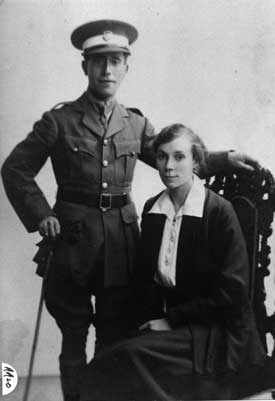
Fred and Mabel Gerrard(née Dyke - daughter of Laura Dyke) [left] kept the Piddlehinton Village Shop at Lantern Cottage from 1920-1952. They took on the Post Office after David Ellis retired.
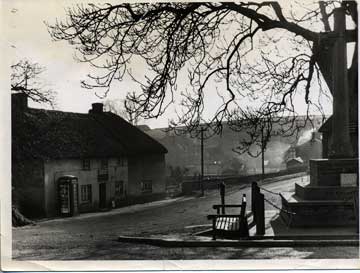
Lantern Cottage as PO & Store
At this time, extra supplies could be obtained from representatives of Dorchester stores - Boons, Parsons and Wrights, or from Puddletown Stores who called to take orders which were delivered by van. Bakers and butchers came from Piddletrenthide. For those with a telephone, a call could be made to several Dorchester stores which would put the goods eg fish, on the bus to be sent out to the village.
Fred and Mabel Gerrard's only son Jack [below], joined the Royal Navy and served for 12 years including the duration of the Second World War.

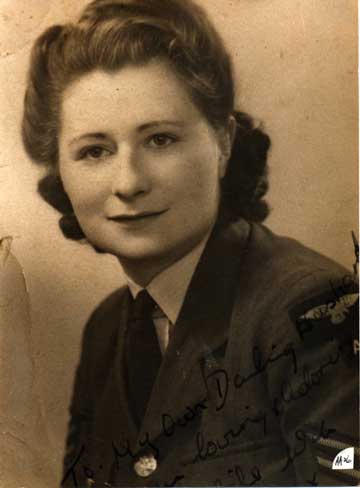
In 1941, he married Wyn Riggs at Piddlehinton Church.

Mr and Mrs Riggs with some of their family outside their cottage near the New Inn
Her father, Bill Riggs, had come to Piddlehinton from Chine Hill (between Piddlehinton and Puddletown). He married Mrs Alice Hoskins, a widow living in High Street, whose husband had been killed in the Boer War. Before joining the army, Mr Hoskins had been a postman, walking daily from Piddlehinton to Cerne Abbas with the mail.
On his arrival in the village, Mr Riggs worked for Miss Riggs (they were not related) at Manor Farm but later he worked as groom and gardener for Mr Walter Lovelace. Mrs Hoskins had two young daughters when she married Mr Riggs. The family continued to live in her home for a while. They later moved to a cottage across the bridge by the New Inn, now demolished. They had five more daughters, the youngest of whom, Wyn, married Jack Gerrard and still lives in the village today.


In the late 1950s the Billens bought Lantern Cottage and the attached house from Eton College for £400 and built a new Post Office and Stores in the garden [Bungalow to the right edge]. This has recently been demolished and is now 2a Rectory Rd.
The Drake family is also remembered by many residents of Piddlehinton. The Misses Suzie and Louie Drake and their brother Dickie had a sweet shop (which also sold a few groceries) in the High Street. Their mother Elizabeth had kept the shop before them between at least 1889-1920. It had a half door and a loud bell. They were all born in the village (Louisa 1873, Richard 1874, Susan 1876) and kept the shop until the 1940s. The sisters were very quaint and dressed in long black skirts with lots of shawls. Dickie was a fine bricklayer and stonemason. He walked, working all the way, from Piddlehinton to Scotland. They are remembered for their funny sayings. Dickie always pulled his wheelbarrow "because he couldn't stand the sight of it". A favourite saying of Suzie's when asked how she was "I dun no I be down t'ground and bide there". She would also say "I 'spose tis true. I dun no if t'll stand movin".

In Medieval times, the church was used as a parish hall. Ale, brewed on the premises and sold for church funds was often drunk during dances and fairs held in the churchyard. One of the duties of the churchwardens was to organise "Church Ales" - rural festivals where ale was consumed. Some references to bad behaviour in church in the churchwardens' accounts and subsequent referral of the offenders to the Manorial Court were perhaps caused by over-indulgence. Alcohol provided the main means of enlivening the dullness of village life!
Inventories from 17th and 18th centuries survive which reveal that private households often brewed ale or made cider on a small scale. On the tithe map, many orchards survived. Other so called "yeomen" turned to larger scale brewing as a means of supplementary income.
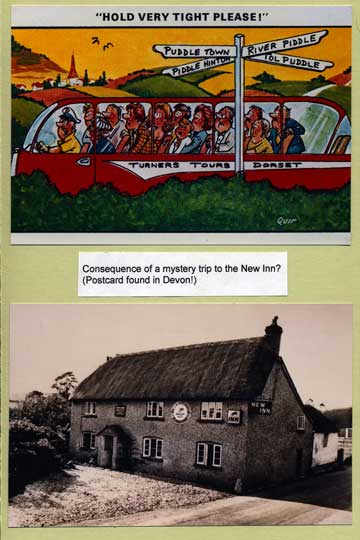
The New Inn was probably built in the late 18th or early 19th century. Messrs Hall & Woodhouse of Blandford acquired the premises on 29th September 1898, when its predecessor, the Woodhouse partnership, became a limited company. In 1898, the Inn was described as 'of mud, brick and flint construction with a thatched roof'. Outbuildings consisted of a stable for two horses, a small coach house, a cowshed and piggery, together with a well, stream, garden and orchard. As the only inn in Piddlehinton it provided (and still does) a focus for much of the social life of the villagers and visiting travellers.
Known licencees and beer retailers in the 19th century included Benjamin Caddy (1841), Richard Smith (1845-51), George Groves (1851-55), Mary Smith (1855-65), Thomas Lovell (1867), Mary Lovell (1875), Giles Cross (1880), Robert Pomeroy (1889-90) and Reuben Caddy (1895).
Later tenants for the brewery included George Damen (1911-1915), Benjamin Gillingham (1920), Mr Williams and F. Hawkins (1923).
When the photograph of the New Inn was taken, Mrs Joyce Clare, daughter of Mr Hawkins, recalled that the stairs to the first floor of the Inn were immediately opposite the entrance door. To the left of the entrance was the Smoking Room, with dartboard and shove ha'penny board. To the right of the stairs was the larger public bar. A back kitchen door opened on to the High Street.
 Mrs Caddy outside the New Inn c. 1900
Mrs Caddy outside the New Inn c. 1900Amongst the village characters using the Inn was shopkeeper and mason, Mr Dickie Drake. Suffering from toothache but fearing the dentist, Mr Drake prevailed upon landlord Hawkins to pull out the offending tooth. This was duly accomplished but, Mrs Clare remembers, not until sufficient whisky had been consumed to give them both strength!
R.J. Waldon followed Mr Hawkins as licensee in 1934, then Albert Penny in 1953. John Somers took on the licence in January 1965, the year in which the inn was substantially changed. It was renamed the Thimble in October of that year. The final landlords for Hall & Woodhouse were Neville Anderson in 1970, Philip Legg in 1985 and Andrew Hunt in 1987. The Thimble was sold by the brewery in 1988 and was a Free House until 2012, when it was bought by Palmers Brewery of Bridport.
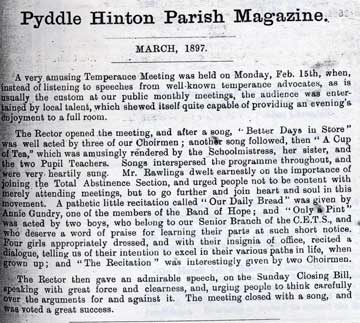
At the time when Victorian society became concerned about the increased drinking in public houses, the Temperance Movement was formed seeking to persuade people to "sign the pledge" and totally abstain from alcoholic drinks. Moderate drinkers were accepted as supporters and a youth movement, the Band of Hope, was formed. The Pyddle Hinton Parish Magazines of 1896-99 show that the movement was thriving, supported by the local clergy.
Master carpenters, their apprentices and journeyman carpenters are listed in available census returns and Kelly's Directory entries 1841-1939.
Four families are worthy of special attention thanks to information supplied by their descendants.

One carpenter, Thomas Squire, born in 1777, came to Piddlehinton with his young wife Elizabeth (nee Day) sometime before 1812. They lived in a cottage on the opposite side of the High Street near the New Inn. Most of their three sons and six daughters were born in Piddlehinton. In the Baptism entries between 1812 and 1820, held by County Records Office, five of their children are mentioned. Thomas Hall b23/02/1812, Louisa b24/01/1812, Theresa b13/03/1816, Charles b07/01/1818, Henrietta b14/01/1820. Thomas was a Carpenter by trade, Elizabeth a "Proprietor" in the 1851 census.

Thomas and Elizabeth rest side by side in the Curchyard, "Lovers to the last".
The cottage burnt down after their time there.
Other members of the family were involved in different trades. Their son Charles [left] is listed in 1841 as a shoemaker, aged 20, still living at home. He was born in the village, married in 1841 and apparently moved away shortly afterwards. He died in 1880.

Daughter Louisa, born in 1815, married the local master saddler and harness maker Richard Lockett [right]. He spent all his working life in the village. He was very involved in the church as Parish Clerk and Sexton for the last 20 years of his life. They lived with their two children - son Thomas born 1851 and daughter Thirza born 1852, opposite the church on the main road. Thirza married the shoemaker Tom Hardy in 1878. He continued in business in the village until his death in 1914. A niece from London, also named Louisa Squire, came to live with them as a baby and grew up with the family.

In 1881, another daughter of Thomas and Elizabeth Squire, Henrietta (born 1820) [left] lived with Richard and Louisa Lockett. She worked in the village as a tailoress and was very good at her trade.
Alfred Squire, the youngest son, was a shopman at the age of 21 in 1851.
At the turn of the 19th century, three carpenters competed for trade in Piddlehinton.
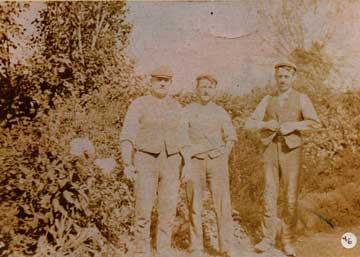
Frederick, Dick and George Smith in the garden at the old mill
The Smith family lived at Waterfall Cottage, next to the old mill, from the 1850s until it burnt down in 1925. Frederick Smith, born 1856, was the son of gardener Richard Smith and his wife Harriet, a laundress. He had been apprenticed to a carpenter in Dorchester. He married Amelia Tuck (born 1853) daughter of local grocer and thatcher George Tuck. They had nine children, four sons and five daughters. Fred, with sons Dick and George, ran their workshop as coachbuilders, carpenters, wheelwrights, joiners and undertakers, on the site of the old mill. George was killed in the First World War.
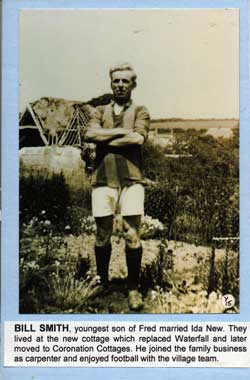
Another son, Bill, came into the business to help out later.
They made coffins in competition with the Saint family, "whoever could get there first".
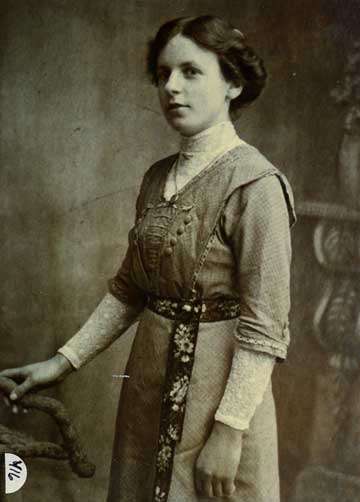
Fred Smith's youngest daughter, Evelyn [Left] (b 1895), married gardener and handyman Charlie Jeanes and continued to live in the family home until their daughter Margaret was three, moving to Glebe (Rectory) Cottage with their other daughters Nancy & Ruth. She was able to help out by lining the individually made coffins with pitch and making pillows of sawdust. She continued to do this after they had moved to the Rectory (now Glebe) Cottage.
Fred Smith died in 1934. Dick Smith carried on as carpenter. He often cut the villagers hair in the carpenter's shop. He was a great talker so it took a long time to have a haircut. The floor was always knee-deep in wood shavings! He made and played his own violin.
The Saint family came to Piddlehinton before 1895. Henry Saint is listed as carpenter in Kelly's Directory for that year, followed by Douglas Saint in 1911 and Albert Saint in 1920. From number 4 High Street, Bert Saint ran a carpenter's and undertaking business. On funeral days, he pushed the coffins to the church on a handcart, always wearing his top hat. The double funeral of Mr and Mrs Fred Groves, who died within a day of each other, was directed by Bert Saint in 1939. Their son Jack, worked on the land for Rex Lovelace in Piddlehinton.
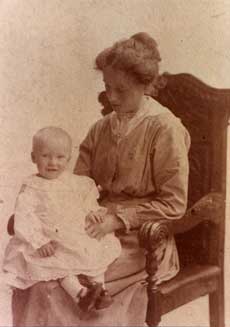
Mabel Saint (née Jeanes) with baby Wilf on lap
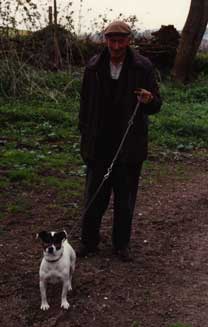
Wilf Saint and constant companion
Jack married a local girl, Mabel Jeanes. Their only son Wilfred, who used to help make the coffins, worked and lived in the village until his death in 1999.

The Gale family c. 1908
L to R : Ethel, Harry, Elsie, Tom, Susie, Arthur, Eva, Dolly, John, Fanny, May, Walter.
On the site of the most recent village shop and post office [demolished and now 2a Rectory Rd], John Gale ran a carpenter's and wagonmaker's workshop from 1911 onwards. John Gale was born in Powerstock, moved to Cheselbourne, then Muston and later to Piddlehinton where he settled with his wife Fanny and their children in the cottage next to Lantern Cottage. They had twelve children.
Arthur, Harry and Walter were at different times apprenticed in the family business. The three eldest sons went to Canada adventuring before the First World War. Tom worked on the Canadian Pacific Railway, before joining the Canadian Army with brothers Harry and Arthur.
Walter, the youngest son served with the Dorset Yeomanry and was killed at Gallipoli. Daughters Eva, Ethel, Elsie and May all married at Piddlehinton Church and moved away. Susie did not marry but moved to Weymouth.
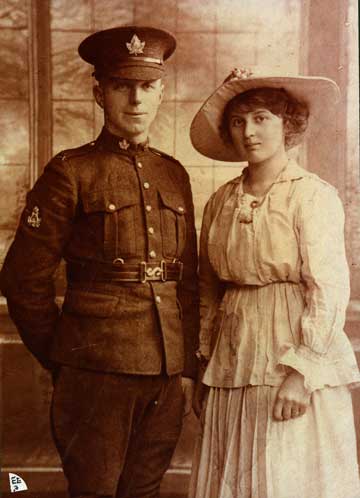
Their eleventh child was named 'Dolly'. Her sister Bessie, who had called her, her very own live dolly, died of pneumonia at the age of 5 years. The family perpetuated the pet name although she had been baptised Alice. At the age of 16, Dolly took up a position as personal maid and companion to Emma, first wife of Thomas Hardy, in the last year of Mrs Hardy's life. Thomas Hardy and Dolly were the only two people present at her bedside when she died. John and Fanny Gale had not wished Dolly to work in the household as Thomas Hardy had a dubious reputation locally. Consequently, Dolly kept this episode in her life a secret. With the outbreak of the First World War, Dolly went into war work. In 1916, she met a young Canadian soldier Tom Harvey. They were married in Piddlehinton Church on New Year's Day 1918.
After the war, they settled in Beaverton on Lake Simcoe in Canada and shared 42 happy years of marriage. Two of their six children were born in England. Tom died in 1960. He never knew of Dolly's time with the Hardys as her story was only uncovered by the English press in the early 1970s, resulting in an article in the Sunday Observer on 14 May 1972. In 1988, aged 92, Dolly Gale Harvey, still lived in Ingersoll, Canada.
Many of the Gale grandchildren were brought back to Piddlehinton to be baptised. Fanny, John, Bessie, Elsie and May all rest in Piddlehinton churchyard.
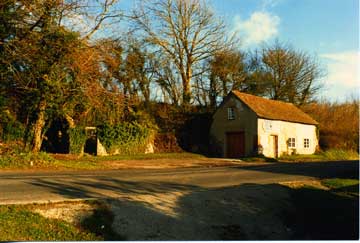
The blacksmith's forge, opposite the mill in the High Street, was converted into a private garage and, in about 2013, into a Holiday let.
Five generations of the Way family ran the blacksmith's business from the 1830s until the 1940s. George Way was born in Tolpuddle in 1799. He brought his wife and three children from Puddletown (where their youngest son James was born in 1827) to settle in Piddlehinton. As a master blacksmith, George employed two hands. James Way became a blacksmith journeyman, and at least two of his five sons, John and Alfred, entered the family trade. John was apprenticed in 1871, aged 15 and presumably took on the responsibility of the village forge on the death of his grandfather George on 10th March 1874. Alfred became a blacksmith journeyman like his father (in the 1881 census, aged 17).
John and his wife Emma also had three daughters, Kate, Agnes and Rose. All three of them became pupil teachers at Piddlehinton School at the turn of the century and went on to train as teachers. Rose Way returned to Piddlehinton School as assistant teacher in 1907, teaching the infant class. She was very musical and was the church organist for 29 years. She helped train the choir and taught local children to play the piano. She played a very active part in village life. She ran the Youth Club and taught the members folk dancing. She was for many years president of the Women's Institute. She formed and ran an adult theatrical group 'The Bright Sparks' who put on various entertainments. They were in great demand and performed in many other places as well as Piddlehinton.

John Way [Left] died in 1927. The newspaper report of the time says

His son Fred [Right] , also followed the family tradition. The smithy was always a great fascination to the villagers. There was always someone looking over the half door watching the horses being shod. Fred Way, in his time, would chase the children with his hammer. It was all in good fun and the air was filled with shrieks of laughter.
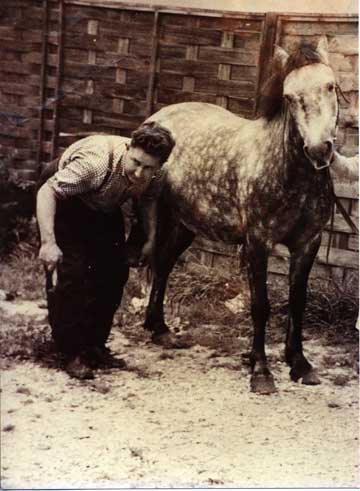
Another of Fred Way's sons, Jack [Left], became the last blacksmith in the village. Fewer horses were kept as the farms became mechanised in the 1940s. Jack Way adapted his business by turning to work on cars.
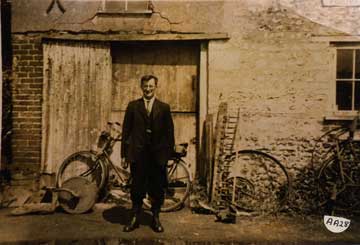
Fred Way's son Bill [Right] outside the forge in the 1930s.
Some of the family still lives locally.
Other blacksmiths in the census returns include Jasper Biles (1841-65), James Biles (retired 1851), George Tuck (1859) and Henry Lake, a black and brightsmith journeyman (1871).
First references to the watermill in Piddlehinton are found in 1440, 1462, and 1571. By the 16th century, it is clear that it was the grist mill for the manor of Piddlehinton (held by Eton College). The demesne farm would have had all its corn ground there. In addition there were 20 copyhold tenants of the manor, each having 24 acres of arable, and 10 tenants with 12 acres of arable. All tenants were required to have their corn ground at the manor mill - the milling 'soke'. As was usual in a manorial mill, the miller was entitled to 1/24th of all the corn he ground - the 'multure' or 'toll' which constituted the miller's pay for his work.
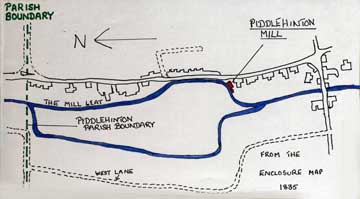
The Tenants were also required to spend the Thursday in Whitsun week cleaning and scouring the mill leat. This flowed for 300 yards along a channel close to the roadside, before turning off at right angles down to the millwheel.
In 1647, the mill had been held by Katherine Lowman, widow of C. Lowman, and was transferred to George White and Honor (nee Lowman). Honor and son Christopher held the lease for 30 shillings a year for their lives.
Amongst other records of the mill and its millers, the following are noted:
- In 1799, the Yeomanry Survey and Proceedings of Defence of the County of Dorset, lists it as a corn mill and therefore a resource for feeding the inhabitants under possible conditions of siege in the Napoleonic Wars.
- In Francis Ingram's Account with the Provost & Fellows, Eton College 1838, he recorded "Of John Dunning, a fine on renewal in the Mills £39-0-0". An earlier reference from Eton mentions tenant John Dunning - Flour mills and Gdn - 27 perches, Stable - 1 perch.
- The Tithe Apportionment of 1838 shows William Moores occupying a House, Mill, Stable and Garden. In May 1841, William Moores insured 'the stock and utensils of his windmill and bakehouse (including cloths for the mill sails and three pairs of millstones)' for £60 with the Sun Insurance Co. This is puzzling as there seems no logical explanation for a windmill in a valley, and no stone foundations remain. It would have been an unusual departure from Dorset custom. No mention of a windmill is found either before or after this one, except for a windmill (windpump) near East Farm buildings, later in the 20th century. A bakehouse was evidently on the premises.
Later millers include Charles Moores in 1845-48. In 1851 James Lovelace was in charge of the mill but census returns indicate William Moores was acting as miller and baker with Ann Lovelace also baker. James Guy is listed as a miller and baker in the same year and Albert caddy as miller's boy. Edward Chilcott is mentioned in 1855, Joseph Buckland as master baker in 1859, 1861 (with John Burgh as miller's boy) and 1867. In the late 1860s, James Clarke from Affpuddle came to Piddlehinton to take over the corn mill. He employed Andrew Gregory as miller's boy in 1871. A master miller, James Clarke was married with four children. He died aged 40 in 1874, leaving his wife Caroline, to carry on the business. She employed one man to help her. References to Caroline Clarke as miller are made in 1875, 1881, 1889-90. A William Stickland is mentioned between these years in 1885. No reference to a miller is found by 1898.

Sometime soon after this, the mill workings were dismantled. The wheel of the mill had been removed before the early years of the 20th century when Mr Frederick Smith and his sons worked on the site as wheelwrights, carpenters, joiners and also undertakers. The mill cottage "Waterfall" burnt down in 1925.
Only one wall of the mill remains. This has a stone pentrough which would have delivered the water to the mill wheel. The last mill wheel in use was breast-shot and operated by the gravity of the water falling into the higher wheel buckets, and dropping out at the bottom, the weight rather than the velocity of the incoming water turning the wheel. The end of the leat near the mill is now dry but can still be traced. The beginning of the leat still flows past the Thimble Inn and along the roadside for a little way. One millstone of Derbyshire Peak stone (Millstone grit) used for coarse grinding also remains.
Census returns and Kelly's Directory entries 1841-1881 list several residents employed as thatchers or in the related occupations of spar-making, hurdling or as woodsmen. They include Jacob Tuck (1841); John Paine, Joseph Groves, Thomas and George Tuck (1851); George Groves, Thomas, George and John Tuck (1861); Thomas and John Jeanes, Richard Foot, John Drake, Alfred and George Groves (1881).
The farms employed local thatchers at harvest time. Before the corn was threshed, the sheaves were stored in thatched ricks. Three months later, the thatch was removed and the dry corn threshed. The straw was then stored in newly thatched ricks. All hay ricks were also thatched.
The preparation of hazel and withy spars, and house thatching provided employment for the remainder of the year. During the war years, house thatching was not allowed. The massive effort to grow corn in the Second World War resulted in 41 barley ricks being thatched on Bourne Farm in a single year. Rick thatching declined with the arrival of the combine harvester.

George Hansford and Jack Osgood thatching together in Plush on 5.8.69
George Hansford was a master thatcher in Piddlehinton for about 50 years. When he first arrived in 1928 there were four other thatchers in the Piddle Valley and they used to share out the work. During his time, he thatched most of the thatched houses in the valley. He was awarded three certificates for his skills and one for teaching. He trained seven apprentices including Jack Osgood, who carried on the business after George Hansford's retirement. Jack married June Croft, who lived at West Lodge Cottages, and is the only remaining local thatcher. He still thatches locally from his Piddletrenthide home.

Ambrose Brown was a boot-repairer who lived and worked at 8 High Street, next to the blacksmith's cottage. Hermann Lea took this photograph before his Piddlehinton days, (in the workshop behind the cottage now called "Cobblers") in 1899 when he was working for John Antell at Puddletown. Mentioned in Kelly's Directory for 1915-1920, several local residents can remember him. He was often called 'Dad' Brown with affection. He often gave the village children apples from his garden. He was buried in the churchyard 7th November 1927, aged 81, soon after this interesting encounter with Mrs Trevett, related in the Piddle Valley Book of Country Life:
'Mrs Ellen Trevett was an old lady who used to lay out the dead and bring in the babies. One day the late Mrs Lovelace met her in Piddlehinton High Street and asked her:
"Where are you going Mrs Trevett?"
"I've got to go up to Ambrose Brown's" she answered. "He've died."
Soon afterwards, Mrs Lovelace was looking out of the window of her house and saw Mrs Trevett coming back.
"You've been quick", she said.
"Well", Mrs Trevett told her, "I went up to Ambrose Brown's and turned back the sheet off his face and he said 'What be you come vor, Mrs Trevett? I 'aven't 'ad me breakfast yet!'"
Sadly, Mr Brown did in fact die a few days later.
Another resident in the early part of this century, remembered by many, was Joey Hardy. He lived in the house next to the river, now known as Bridge House. There were no curtains at the window and a candle could be seen burning on his table when the village children would peep in. He would often tease them and buy them sweets. His son had been killed in the First World War and he lived alone. For income, he relied on selling wild flowers and rabbits at the market. He picked bunches of sweet violets from the hedgerows and has become a legendary figure for his association with snowdrops. Once each year, he would take his seat in church, always at the time that snowdrops were in flower. Parson Newman would see him in the congregation and expect him at the Rectory door a day or so afterwards! Sure enough, he would call round and ask if he might pick some snowdrops from the Rectory garden. The Rector would always oblige and Joey Hardy would take them to Dorchester to sell. In Piddlehinton church we now celebrate Snowdrop Sunday each February in commemoration.